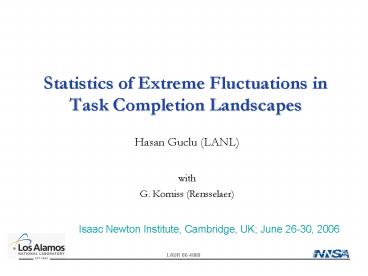Statistics of Extreme Fluctuations in Task Completion Landscapes - PowerPoint PPT Presentation
1 / 16
Title:
Statistics of Extreme Fluctuations in Task Completion Landscapes
Description:
Synchronization is a fundamental problem in coupled multi-component systems. ... statistics is governed by Fisher-Tippet Type I (Gumbel) distribution when noise ... – PowerPoint PPT presentation
Number of Views:48
Avg rating:3.0/5.0
Title: Statistics of Extreme Fluctuations in Task Completion Landscapes
1
Statistics of Extreme Fluctuations in Task
Completion Landscapes
- Hasan Guclu (LANL)
- with
- G. Korniss (Rensselaer)
Isaac Newton Institute, Cambridge, UK June
26-30, 2006
2
Motivation and introduction
- Synchronization is a fundamental problem in
coupled multi-component systems. - Small-World networks help autonomous
synchronization. But what about extreme
fluctuations? Extreme fluctuations are to be
avoided for scalability and stability. - We discuss to what extent SW couplings lead to
suppression of the extreme fluctuations. - One typical example of task-completion systems is
Parallel Discrete-Event Simulation (PDES). - Stochastic time increments in task completion
system correspond to noise in the associated
surface growth problem. We used both exponential
(short-tailed) and power-law noise
(heavy-tailed).
3
Distribution of maxima for i.i.d. random variables
Fisher-Tippett (Gumbel)
Fréchet Distribution
4
Generalized extreme-value distribution (GEVDM)
Castillo, Galambos (1988,1989)
5
Models
Original (1D Ring)
Small-world network
6
Dynamics in the network and observables
Coarse-grained equation of motion
Original (KPZ/EW)
SW Network
Hastings, PRL 91, 098701 (2003) Kozma, Hastings,
Korniss, PRL 92, 108701 (2003)
7
1D ring distribution of maxima
Raychaudhuri, PRL, 01
Majumdar and Comtet (2004)
8
Exponential noise individual height distributions
Fisher-Tippett Type I (Gumbel)
9
Exponential noise maximum height distributions
10
Power-law noise in SW network (p0.1 )
Fréchet Distribution
11
Power-law noise in SW network
12
Extreme fluctuations in scale-free network (exp
noise)
13
Extreme fluctuations in scale-free network
14
Extreme fluctuations in scale-free network
15
Summary
- Small-World links introduces a finite effective
correlation length, so the system can be divided
into small quasi-independent blocks. - When the interaction topology in a network is
changed from regular lattice into small-world or
scale-free, the extreme fluctuations diverge
weakly (logarithmically) with the system size
when the noise in the system is short-tailed and
diverge in the power-law fashion when the noise
is heavy-tailed noise. - The extreme statistics is governed by
Fisher-Tippet Type I (Gumbel) distribution when
noise in the system is exponential or Gaussian
and Fréchet distribution in the case of power-law
noise. - Refs H. Guclu, G. Korniss, PRE 69, 065104
(2004) H. Guclu and G. Korniss, FNL 5, L43
(2005).
16
An incomplete collaboration network of the
workshop































